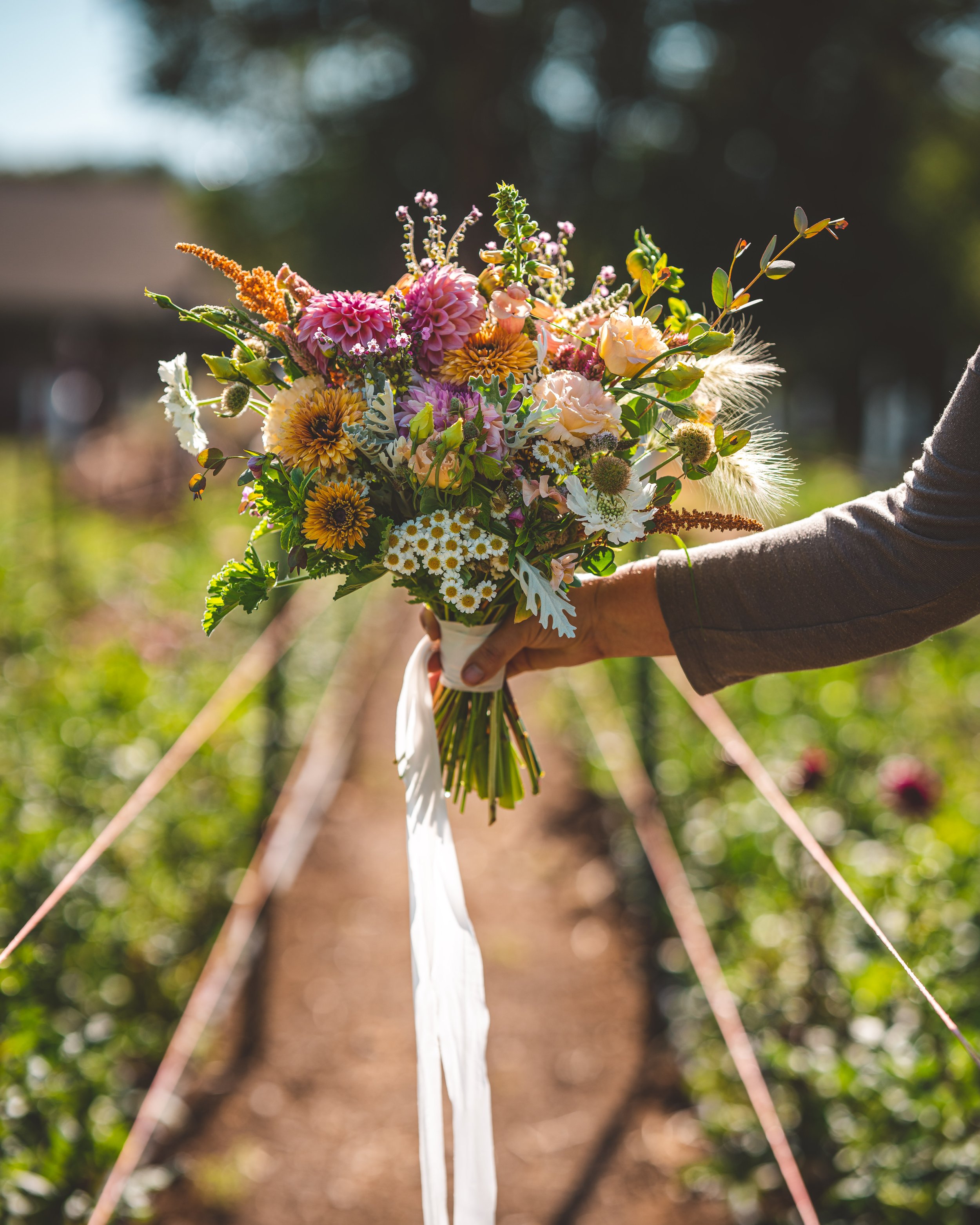Starting Strong | Essential Varieties and Tips for Your First Year of Flower Farming
Deciding to leap into the journey of flower farming brings with it a great sense of excitement and anticipation. Scrolling through seed catalogs, Instagram, and Pinterest can leave you dreaming of growing every beautiful flower you see. However, the reality is that trying to grow too many varieties at once can quickly become overwhelming, especially as you’re learning the ins and outs of flower farming.
The key to success is making strategic choices from the beginning—starting with carefully selecting the flowers you decide to grow. To set yourself up for a successful first year, focusing on varieties that are easier to grow and can nicely fill out a bouquet with minimal stems will not only have you producing gorgeous mixed bouquets but profitable ones as well.
This guide will walk you through the best flower varieties to kickstart your flower farming journey, ensuring that your first year is productive and rewarding.
The Foundation of a Successful Flower Farm
Choosing Easy-to-Grow Varieties
Success in your first year comes from choosing flower varieties that thrive in your garden, are beginner-friendly, and are sought after by customers. Some experimentation will be necessary for your unique climate, but starting with reliable, fast-growing, and highly productive flowers will set you up for success. Cosmos, zinnias, and sunflowers are top choices that fill bouquets beautifully while keeping your farming experience enjoyable and profitable.
Another strategy is to grow dual-purpose varieties, such as everlastings, also known as dried flowers. This approach reduces the pressure to sell all your cut stems fresh, as they can be easily dried for use in the off-season—especially if you're interested in offering wreaths for fall or the holiday season. Strawflowers are one of my go-to varieties—they’re unique in fresh bouquets, great for wedding work, and dry beautifully for off-season offerings. Other excellent options include statice, gomphrena, and bunny tail grass.
Planning for Success
Once you’ve selected your varieties, it’s important to ensure your garden is well-prepared to support healthy growth. Soil is everything—investing in soil health is crucial. Start by taking a soil test in the fall to guide your amendments before winter. If you miss that window, you can also do it in the spring. For more details on the timing of soil tests, refer to the Seasonal Guide to Soil Testing graphic below.
Knowing your soil’s condition helps in choosing the right flower varieties, such as opting for salt-tolerant ornamental grasses if your soil is high in salinity.
Next, consider how you’ll irrigate your crops. Even drought-tolerant plants need consistent water to establish themselves and produce quality blooms. Lastly, understanding your local climate is crucial for planning. Your USDA hardiness zone informs you about overwintering options, while knowledge of frost dates, humidity, and local pests helps you prepare for any challenges ahead.
Top Varieties for a Successful First Year
One of the biggest questions first-year flower farmers often ask is, “What varieties should I start with?” For beginners, the goal is to build confidence while also ensuring profitability. Choosing varieties that are easy to grow, can quickly fill a bouquet, and are relatively affordable to invest in are key qualities to prioritize.
To get you started, here are some of the varieties we’ve found to have all those wonderful qualities:
Zinnias
Zinnias are an easy-to-grow flower that can be started indoors about four weeks before the last frost to get a jumpstart on the season. They can also be direct sown into garden beds, making them ideal for growers with limited seed-starting space. Zinnias come in an array of colors, sizes, and forms, with more being introduced each season. Prolific producers at their peak, they’re especially advantageous for local growers, as they don’t store or ship well—flowers delivered straight from your farm offer the best experience for customers. Zinnias are frost-sensitive, so grow them under similar conditions as tomatoes.
Dahlias
Dahlias are a top performer on our farm. They can be grown from seed, cuttings, or tubers, which multiply and can be divided to build up more stock or sell extras during the off-season. With their unique colors, shapes, and sizes, dahlias are highly requested and perfect for a variety of uses. Ball dahlias have the best vase life, dinner-plate dahlias are showstoppers for events, and pom-pom dahlias are ideal for smaller designs. Much like zinnias, they are best suited for local farms due to their delicate petals.
To learn more about dahlias, read out blog here.
Sunflowers
Sunflowers are cheerful, easy to grow, and boast an impressive vase life. Unique cultivars like burgundy, creamy white, and fluffy doubles help your offerings stand out. Choose pollenless varieties bred specifically for cut flower production to keep flowers tidy and extend their vase life. Mixing branching sunflowers with single-stem varieties gives you a consistent supply throughout the season.
Some other great varieties to consider growing are snapdragons, cosmos, and sweet peas. For more detailed information on how to grow and care for each of these, check out my blog posts on each variety.
Filler Flowers & Foliage
In addition to your main flower varieties, don’t forget the importance of filler flowers and foliage to complete your bouquets. A common mistake first-year flower farmers make is getting caught up in all the pretty blooms and forgetting to plant something to accompany them. While straight bunches can be sold—especially with flowers like sunflowers and dahlias—you can often command a more premium price for bouquets or designs that incorporate a variety of flowers and are finished with foliage. Adding filler flowers and foliage not only elevates the overall look but also gives your arrangements a more polished, professional appearance. For more insights on creating well-rounded designs, check out my blog post on design components.
Ammi & Dara
Some specific varieties, like Ammi and Dara, can add unique texture and visual interest to your arrangements. Ammi, commonly known as Queen Anne’s Lace (Ammi majus), is a quick-growing flower that does well when direct seeded. It’s an umbel flower with tiny, delicate white blooms that appear earlier in the season, just in time to pair beautifully with ranunculus. Queen Anne’s Lace prefers the cooler conditions of spring and usually fades by summer. Another cultivar, Greenmist (Ammi visnaga), is more heat-tolerant, produces more robust stems, and has a subtle green hue.
For a similar look but with more unique colors, consider Dara (Daucus carota), commonly known as Chocolate Lace flower. Dara is particularly swoon-worthy for fall offerings, with a mix of burgundies, whites, and blush tones. Both Ammi and Dara also produce interesting seed heads that can be used to add a "wildflower" aesthetic to your arrangements.
Dusty Miller
Another great addition to your flower farm is Dusty Miller, a versatile foliage that can enhance both fresh and dried arrangements. Dusty Miller is a slower-growing foliage, especially when started from seed, but it easily perennializes, making it a long-term investment for your garden. Dusty Miller is versatile and can be used both fresh and dried. When planted closely together—we space ours seven inches apart—it produces usable stems, making it an excellent choice for cut flower arrangements. From June until frost, we continuously harvest from our Dusty Miller plants, and it’s like the gift that keeps on giving! We grow both the Candicans and New Look cultivars.
Dusty Miller can have a tendency to be floppy, so it’s best used either by embracing its natural form or by supporting it with other components in your arrangements.
Statice
Statice adds beautiful texture and color to mixed bouquets, making it a versatile choice for flower farmers. As an everlasting flower, it's a great addition for growers looking to offer dried flowers in winter. A few stems of statice can quickly and beautifully fill a bouquet, providing your customers with a long-lasting experience that they’ll appreciate.
Tips for a Thriving Flower Farm
Succession Planting
To make the most of your flower farm, it's essential to incorporate smart planting and harvesting practices.
Succession planting will help you have quality blooms to harvest all season long. To learn more about succession planting, read our blog here.
Companion Planting
Companion planting isn’t just for vegetable growers! There are many varieties of flowers that can act as trap crops, deter pests, and encourage beneficial insects to thrive in your flower field. For example, marigolds are known to deter a number of troublesome insects such as thrips, caterpillars, and whiteflies. They also act as a trap crop, luring aphids and leafhoppers while attracting beneficial insects like ladybirds and predatory beetles.
Other flowers like calendula, sunflowers, and yarrow not only serve as beautiful cut flowers but also help to encourage predatory beneficials in the garden. When it comes to creating an oasis for pollinators, any flower will make them happy, but we find that cosmos, scabiosa, honeywort, and zinnias are especially effective!
Harvesting for Optimal Vase Life
Taking the time to learn the best stage to harvest each flower will empower you in the field when you have clippers in hand. Some varieties, such as cosmos, are best harvested at the swollen bud stage, though more open blooms can be used for event work. Other flowers, like dahlias and zinnias, need to be more open when harvested. Additionally, certain varieties should pass what is commonly known as the “wiggle test”—meaning when you shake the stem back and forth, the flower head stays firm and turgid. Flowers like zinnias and rudbeckias benefit from this test.
While each flower variety has its nuances, some basic harvesting practices apply across the board:
Harvest when plants are hydrated: Do this during the cool parts of the day, in the early morning or evening.
Prepare a clean bucket of water: Place cut stems immediately into the water. Depending on your water source, adding a bleach tablet or holding solution may be beneficial. We harvest directly into plain, fresh water.
Use sharp clippers: This ensures a clean cut and helps prevent damage to the stems.
Allow flowers to hydrate before designing: Let the flowers take a good drink and get the field heat off of them before using them in designs. Ideally, allow them to hydrate for at least three hours to ensure a higher-quality product.
Invest in a cooler if possible: Even a small floral cooler or commercial fridge can help extend the vase life of your flowers. If you don’t have a cooler, place flowers in a dark, air-conditioned room and avoid holding them longer than 24 hours before selling to customers.
Starting your flower farming journey can be both exciting and challenging, but with the right strategies and a focus on growing reliable, high-quality varieties, you’ll be well on your way to success. By paying attention to key practices like succession planting, companion planting, and harvesting at the optimal stage, you’ll not only enhance the beauty and longevity of your flowers but also increase your farm’s profitability.
Remember, every season is a learning experience. Don’t be afraid to experiment, adapt, and grow—both in your fields and in your knowledge. Whether you’re planting your first zinnias or perfecting the art of succession planting, each step you take brings you closer to creating a thriving, sustainable flower farm.
We are looking forward to sharing more blooms with you soon.
Jessica & Graham











